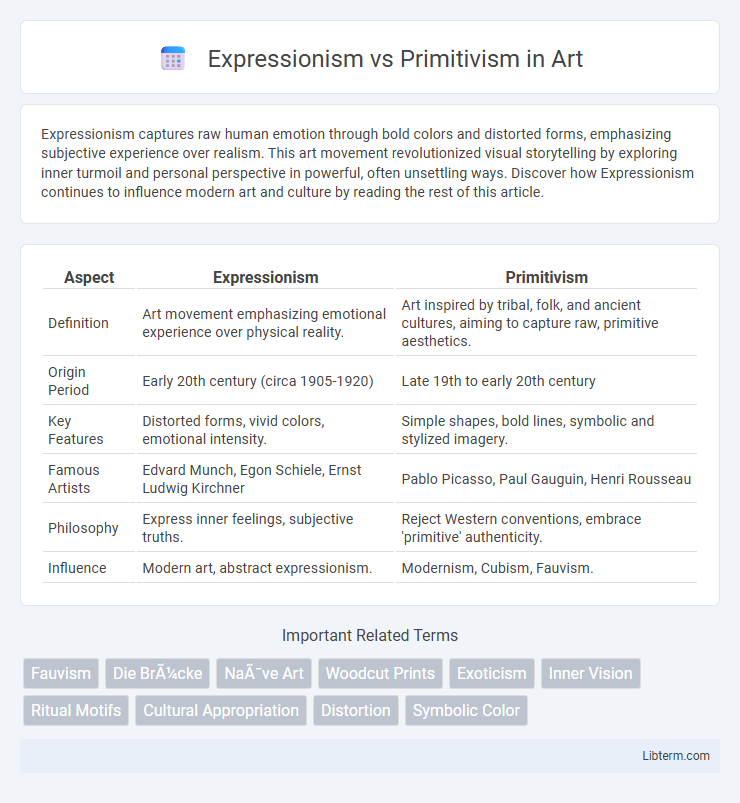Expressionism captures raw human emotion through bold colors and distorted forms, emphasizing subjective experience over realism. This art movement revolutionized visual storytelling by exploring inner turmoil and personal perspective in powerful, often unsettling ways. Discover how Expressionism continues to influence modern art and culture by reading the rest of this article.
Table of Comparison
| Aspect | Expressionism | Primitivism |
|---|---|---|
| Definition | Art movement emphasizing emotional experience over physical reality. | Art inspired by tribal, folk, and ancient cultures, aiming to capture raw, primitive aesthetics. |
| Origin Period | Early 20th century (circa 1905-1920) | Late 19th to early 20th century |
| Key Features | Distorted forms, vivid colors, emotional intensity. | Simple shapes, bold lines, symbolic and stylized imagery. |
| Famous Artists | Edvard Munch, Egon Schiele, Ernst Ludwig Kirchner | Pablo Picasso, Paul Gauguin, Henri Rousseau |
| Philosophy | Express inner feelings, subjective truths. | Reject Western conventions, embrace 'primitive' authenticity. |
| Influence | Modern art, abstract expressionism. | Modernism, Cubism, Fauvism. |
Introduction to Expressionism and Primitivism
Expressionism emerged in early 20th-century Europe as an art movement emphasizing intense emotional experience over physical reality, characterized by distorted forms and vivid colors to convey psychological depth. Primitivism, influenced by non-Western and prehistoric art, sought to return to simpler, more fundamental aesthetics, often idealizing tribal and folk cultures as a source of authenticity and raw expression. Both movements challenged traditional Western art conventions, exploring new ways to express subjective realities and cultural critiques.
Historical Origins and Development
Expressionism emerged in early 20th-century Germany as an avant-garde movement emphasizing emotional experience over physical reality, deeply influenced by social upheaval and rapid urbanization. Primitivism, rooted in Western fascination with non-Western art, particularly African and Oceanic cultures, developed alongside modernism as artists sought to reject industrialization's constraints by embracing perceived raw, elemental aesthetics. Both movements significantly shaped modern art by challenging traditional norms and exploring subjective reality through stark, stylized forms.
Key Philosophies and Artistic Goals
Expressionism emphasizes conveying emotional experience and subjective perspective through distorted forms and vivid colors, aiming to evoke intense feelings and introspection. Primitivism draws inspiration from non-Western and prehistoric art, valuing simplicity, rawness, and a connection to nature and spirituality, seeking to challenge industrialization and modernity's perceived artificiality. Both movements reject realism but differ as Expressionism centers on personal emotion while Primitivism idealizes perceived purity in cultural origins.
Influential Artists and Major Works
Expressionism, with influential artists like Edvard Munch and Egon Schiele, is characterized by intense emotional distortion visible in major works such as Munch's "The Scream" and Schiele's "Portrait of Wally." Primitivism draws from non-Western and prehistoric art, with key figures like Pablo Picasso and Paul Gauguin, evident in Picasso's groundbreaking "Les Demoiselles d'Avignon" and Gauguin's "Where Do We Come From? What Are We? Where Are We Going?" Both movements challenged traditional aesthetics, impacting the trajectory of modern art.
Stylistic Characteristics: Techniques and Forms
Expressionism emphasizes distorted forms, bold colors, and dynamic brushstrokes to convey emotional intensity and subjective experience. Primitivism draws inspiration from non-Western art, featuring simplified shapes, flat perspectives, and raw, often symbolic imagery that evokes a sense of untouched, primal creativity. Both styles reject academic realism, but Expressionism focuses on psychological depth while Primitivism highlights elemental, archaic forms and motifs.
Cultural Context and Social Impact
Expressionism emerged in early 20th-century Europe as a reaction to industrialization and urban alienation, emphasizing emotional experience and subjective interpretation to critique modern society. Primitivism, inspired by non-Western and prehistoric art, challenged Western conventions by idealizing simplicity and perceived purity, influencing avant-garde movements and raising complex debates about cultural appropriation. Both movements significantly impacted social consciousness by questioning traditional aesthetics and highlighting marginalized perspectives amidst rapid societal change.
Expression of Emotion vs. Return to Roots
Expressionism emphasizes the intense conveyance of subjective emotions through distorted forms and bold colors to evoke psychological depth. Primitivism advocates a return to perceived simplicity and authenticity by drawing inspiration from indigenous and prehistoric art, emphasizing raw, elemental qualities. While Expressionism prioritizes emotional intensity, Primitivism seeks to reconnect with cultural origins and fundamental human creativity.
Primitivism’s Influence on Modern Art Movements
Primitivism significantly influenced modern art movements by inspiring artists to incorporate raw, unrefined aesthetics and symbolic motifs drawn from indigenous and ancient cultures. This artistic appropriation challenged traditional Western perspectives, paving the way for styles such as Cubism, Fauvism, and Expressionism to explore abstraction, emotional intensity, and new visual languages. Key figures like Pablo Picasso and Paul Gauguin embraced primitivist elements, integrating them into groundbreaking works that reshaped 20th-century art.
Criticisms and Controversies
Expressionism faced criticism for its intense emotional distortion and subjective perspective, often being accused of exaggerating reality to the point of alienation. Primitivism attracted controversy due to its appropriation and romanticization of non-Western cultures, raising ethical concerns about cultural exploitation and misrepresentation. Both movements sparked debates on authenticity and the moral implications of artistic innovation.
Legacy and Continuing Relevance
Expressionism's legacy lies in its profound influence on modern art, emphasizing emotional experience and psychological depth through bold colors and distorted forms, which continues to inspire contemporary artists exploring subjective realities. Primitivism, while controversial for its appropriation of non-Western cultures, challenged traditional Western aesthetics by valuing raw, elemental forms and spiritual symbolism, leaving a lasting impact on abstract and avant-garde movements today. Both movements remain relevant as they provoke ongoing critical discussions about cultural identity, artistic freedom, and the evolution of visual language in global art practices.
Expressionism Infographic

 libterm.com
libterm.com